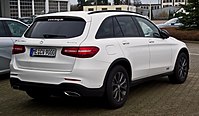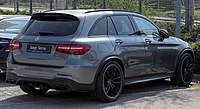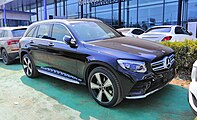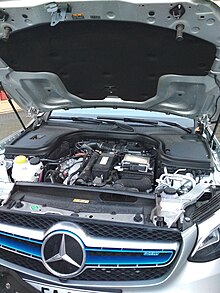Mercedes-Benz X 253
| Mercedes Benz | |
|---|---|
|
Mercedes-Benz GLC 220 d 4MATIC AMG Line (2015-2019)
|
|
| X 253 | |
| Sales designation: | GLC |
| Production period: | since 06/2015 |
| Class : | SUV |
| Body versions : | Station wagon |
| Engines: |
Petrol engine : 2.0–4.0 liters (155–375 kW) Otto hybrid : 2.0 liters (235 kW) Diesel engines : 2.0–3.0 liters (120–243 kW) Diesel hybrid : 2.0 liters (225 kW) |
| Length: | 4655-4682 mm |
| Width: | 1890-1930 mm |
| Height: | 1620-1644 mm |
| Wheelbase : | 2873 mm |
| Empty weight : | 1735-2125 kg |
| Previous model | Mercedes-Benz X204 (GLK) |
| Stars in the Euro NCAP - Crash Test (2015) |
|
The Mercedes-Benz GLC (internal designation: X 253 ) is a compact SUV from the German automobile manufacturer Mercedes-Benz , which has been available on the European market since the end of September 2015. The model designation with the letter G refers to the Mercedes-Benz G-Class as the original model. The letter L historically indicated that the vehicle belonged to the luxury segment , but today it only serves as a connecting element to the third letter C, which indicates that the GLC belongs to the C-Class ( Mercedes-Benz 205 series ) with the the GLC shares a platform .
The GLC is the second generation of this SUV series and replaces the Mercedes-Benz GLK . Initially, two 2.1-liter diesel engines with 125 to 150 kW and a 2.0-liter gasoline engine with 155 kW were offered at the market launch. All of these vehicles with classic combustion engines have turbo-charged engines and, with the exception of the GLC 300 (USA), all-wheel drive . The starting price for the GLC 250 4MATIC is 44,506 euros. With the GLC F-CELL there is also a model with F-Cell drive , the fuel cell technology from Mercedes-Benz.
In April 2015, the design study of the GLC Coupé was presented at the Shanghai Auto Show . The production version of the coupé was presented on March 23, 2016 at the New York International Auto Show , in September 2016 this version was launched as a production vehicle.
At the Geneva Motor Show in March 2019, Mercedes-Benz presented a revised version of the GLC.
gallery
Technical specifications
The GLC was initially only offered in three engine variants ( 250 4MATIC , 220 d 4MATIC and 250 d 4MATIC ). In April 2016, the Mercedes-AMG GLC 43 4MATIC (270 kW / 367 PS) and the plug-in hybrid GLC 350 e 4MATIC (235 kW / 320 PS) were added, with the 2016/2 modification year also the GLC 300 4MATIC and the GLC 350 d 4MATIC . The Mercedes-AMG GLC 63 4MATIC (350 kW / 476 PS) appeared in 2017 .
F-Cell

A pre-production model of the GLC F-Cell was presented at the IAA 2017 and the first technical data was published. The electric motor ( asynchronous machine ) with an output of 147 kW (200 hp) delivers a nominal torque of 350 Nm and drives the rear axle. The electronically limited top speed of the vehicle is 160 km / h. The electrical energy for the drive can be provided by a lithium-ion battery with a net energy content of 9.3 kWh (gross 13.8 kWh) as well as by the fuel cell. A purely electric range of 49 km (according to NEDC) can be achieved using a battery. The battery can be recharged via an on-board charger with a maximum output of 7.2 kW ( plug-in technology ) and is also used for recuperation while driving in all driving modes. The GLC F-Cell is the first fuel cell vehicle whose electrical energy storage can be charged externally. Battery and fuel cell form a symbiosis, with the battery contributing its respective strengths in terms of dynamics and the fuel cell in terms of uniform operation. In addition, the relatively large battery avoids “power peaks” that affect the life of the fuel cell when accelerating and, in view of the small number of hydrogen filling stations, extends the range and possible uses.
Two carbon fiber jacketed tanks with a total capacity of 4.4 kg of hydrogen serve as energy storage for the required hydrogen . As with the B-Class F-Cell, the gaseous hydrogen is stored at a pressure of 700 bar, which enables a refueling time of approx. 3 minutes for a range of 437 km with hydrogen (without taking into account the additional range provided by the battery, a total of 486 km ). The first pressure tank is located in the center tunnel of the vehicle, the second under the rear seat bench. The fuel cell system is significantly more compact than its predecessor, so that it could be fully accommodated in the engine compartment. It is a so-called polymer electrolyte fuel cell (PEM). Compared to earlier PEM fuel cell systems, 90% platinum, 25% weight and 30% installation space could be saved, which makes series use more economical. The combination of the two energy stores increases the curb weight to 2130 kg. The trunk volume is 500–1600 l.
The fuel cell system of the GLC F-CELL has a special technical feature, because for the first time an electric turbocharger is used instead of a screw compressor to supply the fuel cell with air. For the first time, the waste heat from the fuel cell can also be used to drive the turbine, which increases the efficiency of the system by around 15%. A special feature is that the charger shaft is supported by an air gap: This prevents the fuel cell from being contaminated with hydrocarbons from the lubrication of conventional roller or plain bearings.
The GLC F-Cell has been available for leasing as a series model (internal designation N 253) since November 2018. In 2018, 51 GLC F-Cell were newly registered in the Federal Republic of Germany.
On April 21, 2020 it was announced that production of the F-Cell will be discontinued and that no further vehicles based on the fuel cell are planned.
Petrol engines
| Parameters | GLC 200 4MATIC | GLC 250 4MATIC | GLC 300 (USA) | GLC 300 4MATIC | Mercedes-AMG GLC 43 4MATIC | Mercedes-AMG GLC 63 4MATIC + | Mercedes-AMG GLC 63 S 4MATIC + | ||
|---|---|---|---|---|---|---|---|---|---|
| Construction period | since 05/2019 | 06 / 2015–05 / 2019 | since 2016 | 10/2016–05/2019 | since 05/2019 | 06/2016–05/2019 | since 07/2019 | since 04/2017 | |
| Motor designation * | M 274 DE 20 AL | M 276 DE 30 AL | M 177 DE 40 AL | ||||||
| Engine type | R4 petrol engine + electric motor | R4 petrol engine | R4 petrol engine + electric motor | V6 petrol engine | V8 petrol engine | ||||
| Mixture preparation | Direct injection | ||||||||
| Engine charging | turbocharger | Biturbo | |||||||
| Displacement | 1991 cc | 2996 cc | 3982 cm³ | ||||||
| Max. power | 145 kW (197 PS) + 10 kW (14 PS) at 5500-6100 rpm |
155 kW (211 hp) at 5500 rpm |
180 kW (245 PS) at 5500 rpm |
190 kW (258 PS) + 10 kW (14 PS) at 5800-6100 rpm |
270 kW (367 hp) at 5500-6000 rpm |
287 kW (390 hp) at 5500-6000 rpm |
350 kW (476 hp) at 5500-6250 rpm |
375 kW (510 hp) at 5500-6250 rpm |
|
| Max. Torque | 320 Nm at 1650-4000 rpm |
350 Nm at 1200-4000 rpm |
370 Nm at 1300-4000 rpm |
370 Nm at 1800-4000 rpm |
520 Nm at 2500-4500 rpm |
650 Nm at 1750-4500 rpm |
700 Nm at 1750-4500 rpm |
||
| Power transmission | |||||||||
| Drive, as standard | all wheel drive | Rear wheel drive | all wheel drive | ||||||
| Gearbox, as standard | Nine-stage automatic (9G-Tronic) | Nine-stage automatic (9G-Tronic) | AMG SPEEDSHIFT MCT 9-speed transmission | ||||||
| Readings | |||||||||
| Top speed | 215 km / h | 222 km / h | - | 236 km / h | 240 km / h | 250 km / h | 250 km / h (with AMG Driver's Package: 270 km / h) |
250 km / h (with AMG Driver's Package: 280 km / h) |
|
|
Acceleration, 0-100 km / h |
7.9 s | 7.3 s | - | 6.5 s | 6.2 s | 4.9 s | 4.0 s | 3.8 s | |
|
Fuel consumption over 100 km (combined) |
7.1–7.4 l super | 6.5–7.1 l super | - | 7.2–7.7 l Super Plus | 7.1–7.4 l super | 8.3–8.7 l Super Plus | 10.2–10.6 l Super Plus | 10.3–10.7 l Super Plus | 10.7 l Super Plus |
|
CO 2 emissions (combined) |
161-169 g / km | 152-166 g / km | - | 163-174 g / km | 162-169 g / km | 189-199 g / km | 234-242 g / km | 234-244 g / km | 244 g / km |
|
Emission standard according to EU classification |
Euro 6d-TEMP (from 07/2020: Euro 6d) |
Euro 6 (from 07/2018: Euro 6d-TEMP) |
Euro 6 (from 07/2018: Euro 6d-TEMP) |
Euro 6d-TEMP (from 07/2020: Euro 6d) |
Euro 6 (from 07/2018: Euro 6d-TEMP) |
Euro 6d-TEMP (from 07/2020: Euro 6d) |
Euro 6 (from 07/2018: Euro 6d-TEMP) (from 07/2020: Euro 6d) |
||
Plug-in hybrid
The plug-in hybrid GLC 350 e 4MATIC has an electric motor integrated in the transmission housing with a maximum output of 85 kW and a torque of 340 Nm. In conjunction with the four-cylinder M274DEH20LA petrol engine, this results in a system output of 235 kW (320 PS) and a system torque of 560 Nm. According to the NEDC , a purely electric range of 34 km can be achieved. Since auxiliary units such as the water pump , vacuum pump , power steering pump and air conditioning compressor have been electrified, the conventional belt drive is no longer required. The generator is also eliminated, the 12-V power supply is a DC / DC converter fed from the high-voltage onboard network. The approx. 120 kg lithium-ion battery with 8.7 kWh of energy is located behind the rear axle , which reduces the luggage compartment volume from 550 to 395 l with the rear seat back upright. It is a lithium iron phosphate battery consisting of 120 cells (22 Ah, 3.3 V) connected in series with a nominal voltage of 396 V. Overall, the GLC 350 e 4MATIC is 215 kg heavier than the comparable GLC 250 4MATIC . To distinguish it visually from the other engine variants , the GLC 350 e 4MATIC has blue accent panels in the headlights, blue-painted brake callipers at the front and a PLUG-IN HYBRID badge on the fenders.
With the 2020 model year and the facelift, the GLC 300 e 4MATIC was presented at the IAA 2019. The electric motor now has an output of up to 90 kW / 440 Nm, the battery has a capacity of 13.5 kWh, which enables a WLTP range of 43 km. The onboard charger offers up to 7.4 kW AC on 2 phases. The transmission switched to a 9G-Tronic, the petrol engine stayed with the M274.
| Parameters | GLC 350 e 4MATIC | GLC 300 e 4MATIC | GLC 300 de 4MATIC |
|---|---|---|---|
| Construction period | 06/2016–08/2018 | since 11/2019 | since 05/2020 |
| Motor designation * | M 274 DE 20 AL | OM 654 DE 20 SCR | |
| Engine type | R4 petrol engine + electric motor | R4 diesel engine + electric motor | |
| Mixture preparation | Direct injection | Common rail direct injection | |
| Engine charging | turbocharger | ||
| Displacement | 1991 cc | 1950 cc | |
| Max. power | 155 kW (211 PS) + 85 kW (116 PS) at 0-2000 rpm system output 235 kW (320 PS) |
155 kW (211 PS) at 5500 rpm + 90 kW (122 PS) system output 235 kW (320 PS) |
143 kW (194 PS) at 3800 rpm + 90 kW (122 PS) system output 225 kW (306 PS) |
| Max. System torque | 560 Nm | 700 Nm | |
| Power transmission | |||
| Drive, as standard | all wheel drive | ||
| Gearbox, as standard | 7-speed automatic (7G-TRONIC Plus) | 9-speed automatic (9G-TRONIC) | |
| Readings | |||
| Top speed | 235 km / h | 230 km / h | |
|
Acceleration, 0-100 km / h |
5.9 s | 5.7 s | 6.2 s |
|
Fuel consumption over 100 km (combined) |
2.5 l super | 2.2–2.5 l super | 1.9–2.0 l diesel |
|
CO 2 emissions (combined) |
59 g / km | 50-58 g / km | 45-51 g / km |
|
Emission standard according to EU classification |
Euro 6 | Euro 6d-TEMP (from 07/2020: Euro 6d) |
Euro 6d |
Diesel engines
| Parameters | GLC 200 d 4MATIC | GLC 220 d 4MATIC | GLC 250 d 4MATIC | GLC 300 d 4MATIC | GLC 350 d 4MATIC | GLC 400 d 4MATIC | |
|---|---|---|---|---|---|---|---|
| Construction period | since 04/2019 | 06 / 2015-04 / 2019 | since 05/2019 | 10/2016–05/2018 | since 07/2019 | ||
| Motor designation + | OM 654 DE 20 SCR | OM 651 DE 22 LA | OM 654 DE 20 SCR | OM 642 LS DE 30 LA | OM 656 D 29 R SCR | ||
| Engine type | R4 diesel engine | R4 diesel engine | V6 diesel engine | R6 diesel engine | |||
| Mixture preparation | Common rail direct injection | ||||||
| Engine charging | turbocharger | Biturbo | turbocharger | Biturbo | |||
| Displacement | 1950 cc | 2143 cc | 1950 cc | 2987 cc | 2925 cc | ||
| Max. power | 120 kW (163 hp) at 3200-4600 rpm |
143 kW (194 hp) at 3800 rpm |
125 kW (170 hp) at 3000–4200 rpm |
150 kW (204 hp) at 3800 rpm |
180 kW (245 PS) at 4200 rpm |
190 kW (258 hp) at 3400 rpm |
243 kW (330 hp) at 3600-4000 rpm |
| Max. Torque | 360 Nm at 1600-3000 rpm |
400 Nm at 1600-2800 rpm |
400 Nm at 1400-2800 rpm |
500 Nm at 1600-1800 rpm |
500 Nm at 1600–2400 rpm |
620 Nm at 1600–2400 rpm |
700 Nm at 1200–3200 rpm |
| Power transmission | |||||||
| Drive, as standard | all wheel drive | ||||||
| Gearbox, as standard | Nine-stage automatic (9G-Tronic) | ||||||
| Readings | |||||||
| Top speed | 205 km / h | 215 km / h | 210 km / h | 222 km / h | 231 km / h | 238 km / h | 240 km / h |
|
Acceleration, 0-100 km / h |
8.9 s | 7.9 s | 8.3 s | 7.6 s | 6.5 s | 6.2 s | 5.1 s |
|
Fuel consumption over 100 km (combined) |
5.2-5.4 l diesel | 5.0-5.5 l diesel | 5.7-5.9 l diesel | 5.9–6.2 l diesel | 6.4–6.7 l diesel | ||
|
CO 2 emissions (combined) |
137-144 g / km | 129-143 g / km | 151-157 g / km | 159-169 g / km | 168-176 g / km | ||
|
Emission standard according to EU classification |
Euro 6d | Euro 6 | Euro 6d | Euro 6 | Euro 6d | ||
production
The GLC is mainly manufactured at the Mercedes-Benz plant in Bremen and Beijing. Due to the high demand, the GLC has also been produced by the Finnish contract manufacturer Valmet Automotive since the beginning of 2017 . Valmet Automotive is expected to deliver 50,000 units annually. Since the fourth quarter of 2018, the GLC has also been manufactured in the Pune plant ( India ) and delivered from there to the USA, after the US market was previously served by the Bremen plant.
See also
Web links
Individual evidence
- ↑ Result of the Mercedes-Benz GLC-Class in the Euro NCAP crash test (2015)
- ↑ Christian Beckmann: Off-road luxury, compact. In: www.autobild.de. January 3, 2008, accessed June 6, 2020 .
- ↑ Mercedes changes series designations. In: www.auto-motor-und-sport.de. Retrieved June 6, 2020 .
- ↑ Christian Beckmann: Off-road luxury, compact. In: www.autobild.de. January 3, 2008, accessed June 6, 2020 .
- ↑ Technical data of the new GLC , accessed on June 19, 2015
- ↑ Holger Wittich, Uli Baumann: Mercedes GLC Coupé (2016): SUV Coupé attack against BMW X4 - Auto Motor und Sport. auto-motor-und-sport.de, April 19, 2015, accessed on December 19, 2015 .
- ↑ The new GLC Coupé - teaser. mercedes-benz.com, accessed on March 22, 2016 .
- ↑ Holger Wittich: Erlkönig Mercedes GLC Coupé: SUV Coupé attack from 2016 - Auto Motor und Sport. auto-motor-und-sport.de, November 10, 2015, accessed on December 19, 2015 .
- ↑ Stefan Leichsenring: Mercedes GLC Facelift (2019) in Geneva: New engines and assistance systems. In: motorsport-total.com. March 15, 2019, accessed January 11, 2020 .
- ↑ New change year 807: GLC 350 e 4MATIC and GLC 43 4MATIC can be ordered , accessed on November 16, 2016
- ↑ Change year 16/2 brings the 350 d 4MATIC and 300 4MATIC into the GLC , accessed on November 16, 2016
- ↑ Technical data of the GLC 450 AMG Sport and announcement GLC 63 AMG , accessed on July 5, 2015
- ↑ a b IAA 2017: World premiere for the GLC F-CELL pre-production model # IAA2017 # MBIAA17 - Mercedes-Benz Passion Blog / Mercedes Benz, smart, Maybach, AMG . In: Mercedes-Benz Passion Blog / Mercedes Benz, smart, Maybach, AMG . September 12, 2017 ( mercedes-benz-passion.com [accessed September 13, 2017]).
- ↑ The first fuel cell Mercedes can do that. Retrieved April 7, 2018 .
- ↑ Michael Specht: Mercedes GLC F-Cell: With steam into the future. In: Der Spiegel . April 3, 2018. Retrieved August 29, 2018 .
- ↑ GLC F-Cell: Mercedes is giving hydrogen again . ( handelsblatt.com [accessed April 7, 2018]).
- ↑ Joachim Becker: The fuel cell is alive again . In: sueddeutsche.de . September 11, 2017, ISSN 0174-4917 ( sueddeutsche.de [accessed April 7, 2018]).
- ↑ Mercedes-Benz GLC Fuel Cell: First tour in a battery-fuel cell SUV. Retrieved April 7, 2018 .
- ↑ Driving report Mercedes GLC F-Cell: Electric car with fuel cell . ( adac.de [accessed on November 10, 2019]).
- ↑ Mercedes-Benz GLC F-CELL: Market launch for the world's first electric vehicle with fuel cells and plug-in hybrid technology. Retrieved February 25, 2019 .
- ↑ New registrations of motor vehicles according to environmental characteristics (2018). Retrieved January 17, 2020 .
- ↑ Mercedes ends production of GLC F-Cell
- ↑ Driving report Mercedes-Benz GLC , accessed on November 18, 2016
- ↑ a b c D. Görke, S. Schmiedler, J. Strengert: Plug-in hybrid by Mercedes-Benz - The technology kit for future consumption targets , in: 16th International Stuttgart Symposium 2016, pp. 265–280, Springer Fachmedien , Wiesbaden
- ↑ a b practical test with Mercedes' eco-SUV , accessed on November 18, 2016
- ↑ New year of change 807: GLC 350 e 4MATIC and GLC 43 4MATIC can be ordered , accessed on November 18, 2016
- ↑ https://blog.mercedes-benz-passion.com/2019/11/glc-300-e-4matic-nun-bestellbar-noch-keine-foerderung-der-bafa/
- ↑ Markus Jordan: GLC production started at Valmet Automotive in Finland. MBPassion, February 19, 2017, accessed February 21, 2017 .
- ↑ Mercedes wants to import GLC from India to the USA. automobilproduktion.de, September 27, 2018, accessed on August 19, 2019 .
- ↑ Sudden stop for India's auto industry. Neue Zürcher Zeitung, August 18, 2019, accessed on August 19, 2019 .
| Vehicle class | 1920s | 1930s | 1940s | ||||||||||||||||
| 6th | 7th | 8th | 9 | 0 | 1 | 2 | 3 | 4th | 5 | 6th | 7th | 8th | 9 | 0 | 1 | 2 | 3 | 4th | |
| Compact class | W 15 (type 170) | ||||||||||||||||||
| W 23 (type 130) | |||||||||||||||||||
| W 30 (type 150) | |||||||||||||||||||
| W 28 (type 170 H) | |||||||||||||||||||
| Middle class | W 02 (type Stuttgart 200) | W 136 / W 149 (types 170 V / 200 V) | |||||||||||||||||
| W 11 (type Stuttgart 260) | W 143 (type 230 n) | ||||||||||||||||||
| W 21 (type 200/230) | W 153 (type 230) | ||||||||||||||||||
| W 138 (type 260 D) | |||||||||||||||||||
| upper middle class | W 03 / W 04 / W 05 (types 300/320/350) | W 18 (type 290) | |||||||||||||||||
| W 10 / W 19 (types 350/370/380) | W 142 (type 320) | ||||||||||||||||||
| W 22 | |||||||||||||||||||
| Upper class | Type 400 & Type 630 | W 24 / W 29 / W 129 (types 500 K / 540 K / 580 K) | |||||||||||||||||
| W 08 (type Nürburg 460/460 K / 500 / type 500 N) | |||||||||||||||||||
| W 07 / W 150 (types 770/770 K) | |||||||||||||||||||
| Sports car | Model K | ||||||||||||||||||
| W 06 (type S / SS / SSK / SSKL) | W 24 / W 29 / W 129 | ||||||||||||||||||
| Off-road vehicle | W 103 (type G1) | W 31 (type G4) | |||||||||||||||||
| W 133 III (type 170 VG) / W 139 (type 170 VL) / W 152 (type G5) | |||||||||||||||||||
| Vans | L 3/4 | L 1000 Express | L 301 | ||||||||||||||||
| L 300 | |||||||||||||||||||









